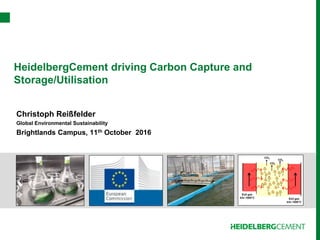Carbon Capture and Storage in the Cement Industry
- 1. Christoph Reißfelder Global Environmental Sustainability Brightlands Campus, 11th October 2016 HeidelbergCement driving Carbon Capture and Storage/Utilisation
- 2. HeidelbergCement in the world Number 1 in aggregates, number 2 in cement, and number 3 in ready-mixed concrete HeidelbergCement Italcementi HeidelbergCement and Italcementi
- 3. Expanded HeidelbergCement Group in figures 63,000 employees Core business – Aggregates – Cement – Downstream activities: ready-mixed concrete and asphalt 3,030 locations in around 60 countries (incl. joint ventures) – 620 production sites for sand, gravel, and crushed rock – 161 cement and grinding plants – 1,740 ready-mixed concrete plants – 114 asphalt plants Cement capacity 197 million tonnes (incl. joint ventures) Aggregates reserves 19 billion tonnes
- 4. Contents 1. Climate change & cement 2. Carbon Capture 3. CO2 utilization 4. Concluding remarks
- 5. Cement manufacturing explained in 1 minute Limestone CaCO3 Calcining to CaO Sintering to clinker Grinding to cement 1,6 ton limestone + 0,1 ton coal = 1 ton cement + 0,8 ton CO2
- 6. We reached the turning point: coal fired power is out!
- 7. Mandatory to deploy CCS/CCU to reach our goals! 4 levers to reduce CO2 Energy efficiency 27% Alternative fuels 19% Clinker substitution 9% Carbon Capture & S/U 46% 2016
- 8. The cement sector will face one of the highest costs for carbon capture (excluding the power sector) Iron & steel Cement 500 Mt/y 1.500 Mt/y 70 €/t 40 €/t AFR & Clinker substitution Technology
- 9. HeidelbergCement beliefs & strategy (I) Carbon Capture and Storage (CCS) is required for a full de-carbonization of cement industry CCS needs financial supporting mechanisms to be competitive* feasible *imports/steel CCS lacking public acceptance in mainland EU, sufficiently accepted in Scandinavia and Canada Carbon Capture & Utilization (CCU) commercial today for small high-value-end-products CCU potential to significant contribute to CCS/U targets for cement industry in focus Reliable technology Financially sound Public acceptance
- 10. HeidelbergCement beliefs & strategy (II) CCS and CCU are mainly in pre-competitive phase HeidelbergCement encourages and initiates collective approaches – within the cement industry WBCSD-CSI ECRA – and beyond lime-industry automotive industry start-ups
- 11. Carbon Capture
- 12. Large Scale Carbon Capture Norway Test program 12 m€ final end 2016 – 75% funding government – Amine scrubbing most reliable technology Feasibility study done – 40% CO2 capture using waste heat Brevik – > 100m€ investment needed (+/- 30%) – OPEX: > 40 €/t clinker – CO2 from fertilizer industry + refinery will be combined for shared storage Next steps – Evaluate to which extend Government of Norway can finance CAPEX and OPEX to avoid competitive out ruling of Norcem – Evaluate how much HC can “bare” to remain competitive – 1½-2 years to finalize this phase
- 13. CEMCAP 9 mio € EU funding September 2015 Econsense Berlin Slide13 Oxyfuel Cement Kiln Cooler Prototype: HC-Hannover Calciner prototype: HC-Italcementi Burner prototype University of Stuttgart CO2-enrichment: Oxyfuel Project for Cement Kilns Funding in progress Slite 7 qualified as demoplant
- 14. Consortium Indirect heating raw meal: – Separate process CO2 – Calix MgO proven process 10 tph demonstration plant, Lixhe-Belgium – Cement & Lime applications – www.leilac.org.uk LEILAC: CO2 separation@calcining (12 m€ EU-Horizon 2020)
- 15. Carbon Capture and Utilization
- 16. Technology supplier Design + supply equipment Part of CAPEX Energy-company Construction + Operation Power control market Part of CAPEX CO2 and H2 (made by excess renewable energy) to CH4 CO2-supply Electricity supply Part of CAPEX Owner of the facility Cement plant HC CO2 Automobile company E-gas offtake Status of e-gas Marketing of e-gas cars
- 17. CCU with cyano bacteria and micro-algae Modified bacteria to ethanol Strategic Partnership with Joule Ltd Large space required and solar radiation EU funding not approved Audi cooperation partner with Joule Pilot test possible in combination with micro-algae Microalgae for fish & fowl feed Sweden & Turkey Microalgae are reacting positively to the flue-gas of cement kilns Algal biomass can be a base material for fishmeal and animal feed
- 18. Market – interesting for cement-industry Fishmeal Partner 2020 commercial Ethanol as fuel Partner Joule (+Audi) 2025 commercial
- 19. Carbon8: carbonating CaO rich ashes to light weight aggregates Flue gas 20% CO2 85% of flow 15% of flow CKD, sand oil shale ash
- 20. Concluding remarks The cement industry set ambitious targets on CO2 reduction in the CSI-Roadmap 2050 Carbon Capture requires intensive cooperation in our industry and HeidelbergCement is demonstrating leadership in this domain In its operations worldwide HC is testing and developing (commercial) use of CO2 from our stacks applying various technologies
- 21. CO2 will become a valuable asset….. Christoph Reißfelder Assistant Biodiversity & Public Affairs Global Environmental Sustainability jan.theulen@heidelbergcement.com +31 62 9097 354 Contacts:

